Knowing how to correctly water your basil is perhaps the most important thing if you want big and productive plants. How much and how often you should water your basil depends on many things, but don’t worry, because I will explain everything you need to know in this article, no matter if you grow your basil indoors or outside, in pots, or in the ground.
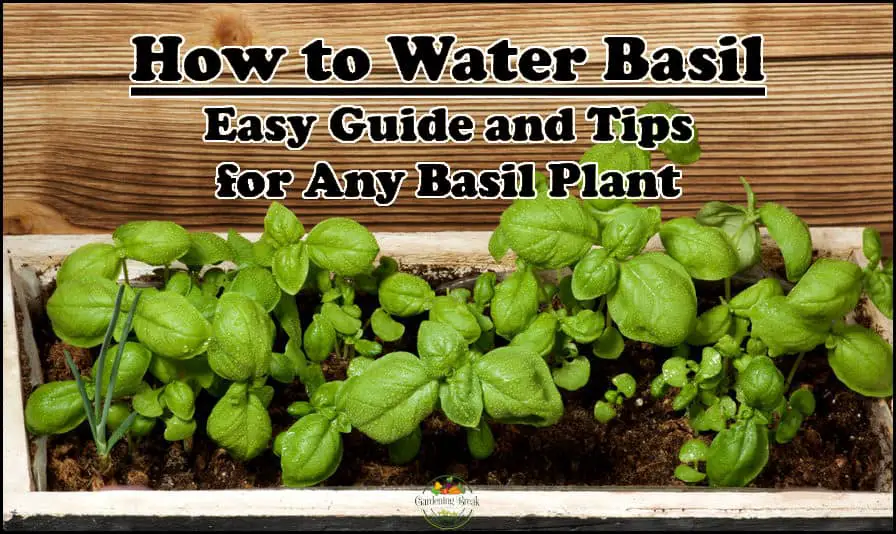
Basil was one of the first plants I grew at home many years ago and I have been growing it every year since then. Throughout the years, I have learned a lot of great tips about how to correctly water it and I want to share those tips with you.
As a general rule, basil plants should be watered when the top of the soil they grow in is dry. Do not allow more than the top of the soil to become dry, however, since that can kill the roots and thereby the whole plant. Watering too much can cause the roots to rot, which also kills the plant.
As I explained earlier, how to correctly water basil depends on plant size, growing conditions, and more. In this article, I explain everything you need to know to correctly water your basil no matter how large it is and where and how you are growing it.
Here is what I cover in this article:
- How often you should water your basil
- How much water to give your basil
- Signs that basil needs to be watered
- The best time of the day to water basil
- Common problems when watering basil and how to solve them
- Specific tips for watering basil that grows in pots, in the ground, indoors, and outside
To make it as easy as possible for you to find what you’re looking for, I have highlighted the most important takeaways from each of the points from the list throughout the article.
How Often to Water Basil (Depending on Size, Weather, Etc.)
Basil plants usually need to be watered every 3-4 days, but it depends on several things including the size of the plant, the weather, how much sunlight the plant gets, the temperature, and whether it is growing indoors or outside as well as in a pot or in the ground.
Here are the most important things to know about how often to water basil.
- Water basil when the top of the soil (but only the top) feels dry.
- Small basil plants need to be watered more often than large basil plants (but in smaller doses).
- Basil plants need to be watered more often during warm and sunny periods.
It is usually sufficient to water basil plants every 3-4 days, but during warm periods with high amounts of sunlight, it may be necessary to do it every day. In colder periods without much sunlight, it can be sufficient to water basil one time per week.
This is just a general rule of thumb. If you want to be sure about how often to water your basil, I have some tips for you.
The easiest way to tell that it is time to water your basil is to feel the top of the soil. If it is wet or moist, you shouldn’t water the plant, but if it is dry, you should water it. A trick I sometimes use is to stick a finger about 2 inches (5 cm) into the soil. If the finger comes out dry, it is time to water the plant. If it comes out wet, you can wait.
Basil needs to grow in soil that is moist and not too wet or too dry, so it is important that you don’t let the soil dry out completely or the plant will die. Only the top of the soil should dry out before you water the plant again.
The soil should, ideally, look somewhat similar to the soil in this photo of one of my basil plants. It is not the best photo I have ever taken, but notice how the soil looks moist without looking wet or soaked and also not dry.
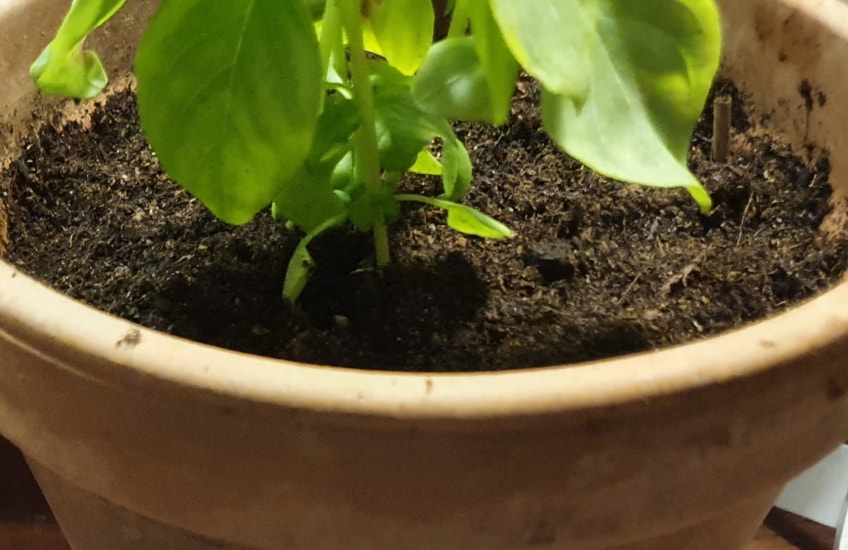
Seedlings and small basil plants don’t have nearly as big a root system as large and more established basil plants, so they can’t obtain nearly as much water. The smaller the plant is, the less water it can obtain, so the best thing to do is to water it slightly more often but in smaller doses to avoid overwatering it.
For potted basil, the size of the pot also plays a role in how often to water the plant since small pots can’t contain as much water as large pots. Therefore, basil plants in small pots should be watered more often than basil plants in large pots.
The key takeaway is that you should look at the top of the soil your basil is growing in. Don’t water your basil before the top of the soil is dry to avoid overwatering and don’t wait too long after that either or the plant will dry out.
How Much Water Should You Give Basil? How to Know
Basil plants are relatively sensitive to being overwatered and underwatered, so it is important that you know how much water they need.
A lot of factors go into determining how much water a basil plant needs. It mostly depends on the size of the plant, but conditions such as the soil content, amount of sunlight, and temperature also play a big role.
Here is a good general rule of thumb you can follow to give your basil the correct amount of water.
- Basil generally needs approximately 1-1½ inches of water per week on average.
- Use more water during warm and sunny periods and less during cold and cloudy periods.
As I wrote above, there is, unfortunately, not a universally correct amount of water to give basil because it depends on several things. The 1-1½ inches of water per week is just a rule of thumb.
An important thing to keep in mind is that basil plants that grow indoors usually don’t need as much water as basil that grows outside, since they are not exposed to as much direct sunlight. You can read more about the differences between growing basil indoors or outside in the article on this link.
Seedlings and small basil plants also don’t need as much water as large ones. The reason is that their root system is not nearly as large, which means that they cannot obtain nearly as much water. That also means that seedlings are at higher risk of being overwatered or drying out than larger plants.
To be honest, I rarely measure precisely how much water I give my basil plants and they usually thrive. I usually give small plants about 1-2 cups of water and larger plants 3-4 cups of water per watering, but that doesn’t necessarily mean you should do the same.
The most important thing is to not allow the soil to dry out or get too wet. Sometimes you need to use more water than other times, especially during warm and sunny periods.
As I wrote earlier in this article, do your best to keep the soil moist without getting it too wet or letting it dry out. Stick a finger about 2 inches (5 cm) into the soil to see if it feels dry or moist. If it is dry, your plant needs water, if it is moist, you have given it enough.
2 Clear Signs That Your Basil Needs to Be Watered
One of the most important things to avoid problems when you water basil is to know the signs that your plants need to be watered.
Here are two signs that it might be time to water your basil. I will elaborate below.
- The plant is wilting.
- The top of the soil looks and feels dry.
When basil plants wilt, their foliage will seem loose and sloppy. The plant essentially looks thirsty. Here is what wilting basil looks like.
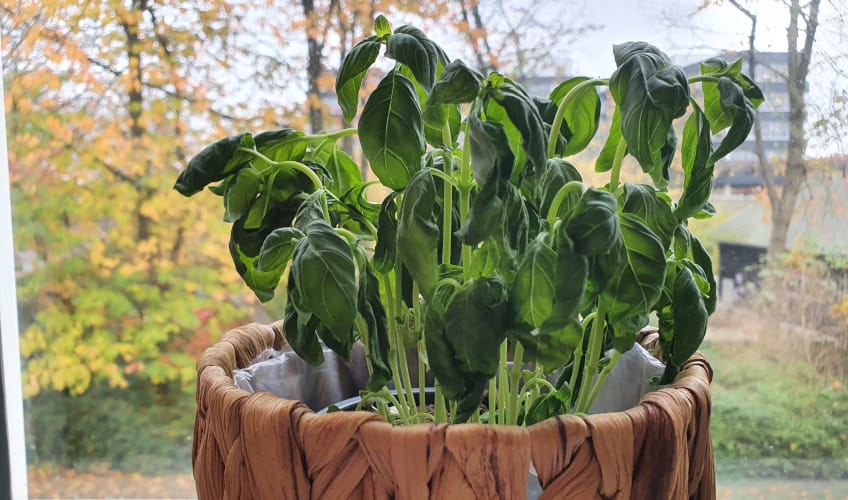
It is important to remember that basil also begins wilting as a result of overwatering, so the best way to make sure overwatering isn’t the problem is to check the soil.
If the soil looks and feels dry, give your basil some water. If it feels moist or wet and your basil is wilting, do not water it more. It is most likely wilting because it has been overwatered and there is too much water in the soil around the roots, which prevents them from obtaining oxygen. I go into more detail about this a bit later in this article.
Best Time to Water Basil (Avoid Watering Problems)
When I first started growing basil, I didn’t know how much of a difference it makes to water it at the right time. Now I know that it can both make the plant grow much better and reduce the risk of several problems.
Here is the key takeaway.
- The best time to water basil is in the morning.
- If your basil needs water, you should water it regardless of the time.
The most important reason why it is best to water basil in the morning is that the plant needs water throughout the day when the sun is shining. The warmer and sunnier it is the more water basil needs. So if you don’t water it in the morning, you risk that the plants dry out during the day.
Additionally, when you water your basil in the morning, the water has time to seep down into the soil. If you water in full sun later in the day, you risk that a lot of the water evaporates before your basil plants have a chance to obtain it.
Lastly, if you water in the evening, most of the water will stay in the soil around the roots until the next day. This happens because there is no sunlight at night, which means that the plants barely use any water. If water stays around the roots for too long, the roots will eventually rot, which kills the plant.
It won’t harm your basil plants if you water them in the evening once in a while, but avoid doing it every day. One thing you risk by doing this too often is that mold will develop on the soil and eventually on the plant. If you see mold on the soil around your basil plant, head over to this article where I explain how to solve the problem.
All of this being said, if your basil is showing signs that it needs water, you should give it some water, regardless of what time of the day it is.
5 Things to Avoid When Watering Basil (Important)
Incorrect watering might be the most common reason why people have problems when growing basil. Watering basil wrong can increase the risk of pests and diseases and even cause the plant to die.
The most common mistake people make when they water basil is to either water it too much or too little. Both can lead to several different problems and can even kill the plant. Overwatering and underwatering aren’t the only things to avoid when watering basil, though, so keep reading as I explain.
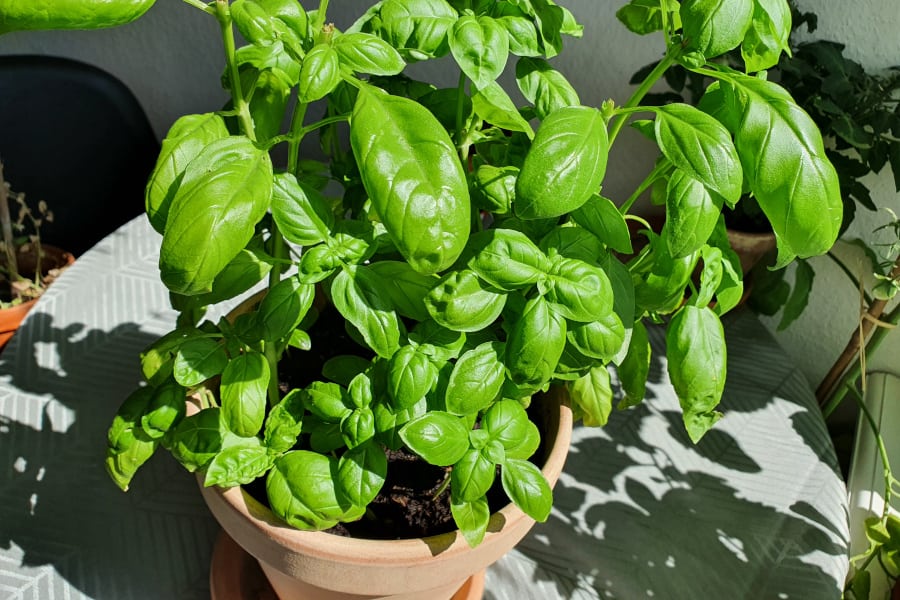
Here are five things you should avoid when watering your basil. I share some easy tips to avoid them below.
- Avoid overwatering.
- Avoid underwatering.
- Avoid getting water on the foliage.
- Avoid watering in the evening if possible.
- Don’t water with too high pressure.
Avoid overwatering and underwatering
Some of the signs of overwatering and underwatering are similar. The most common sign is wilting. It can easily seem like a wilting basil plant is thirsty, and sometimes it is, but it can also happen because it has been overwatered. I have certainly overwatered basil a few times in the past because of that.
In fact, I got so tired of overwatering my basil a while ago that I decided to learn everything I could to avoid doing it again. I share everything I learned in this article, where I cover not only how to avoid overwatering your basil, but also how to identify the issue as early as possible and how to save the plant.
The best way to avoid overwatering and underwatering basil is to water it only when the top of the soil is dry. If you water before that, you risk overwatering it and if you allow more than just the top of the soil to dry out, the roots can dry out and die.
If the damage from overwatering is severe, sometimes the only thing you can do to save your basil plant is to transplant it to another pot or into the ground. I have an easy step-by-step guide for that on this link.
Avoid getting water on the foliage
Another thing you should avoid when possible is to get a lot of water on the foliage of your basil plants. This is because leaves that stay wet for a long time are more at risk of rotting or attracting pests and diseases.
Getting water on your basil’s foliage is not nearly as critical as overwatering and underwatering and your basil won’t die if you get water on the foliage once in a while. It also rains outside once in a while, after all. Just try to keep it in mind and pour water directly onto the soil instead of over the plant when you water it.
A great way to water potted basil is to water it from the bottom. There are several advantages to doing so other than avoiding getting water on the leaves. For example, it promotes root growth, which allows your basil to obtain more water and nutrients and thereby grow faster and get bigger. You can read more about that in the article on this link.
Avoid watering in the evening if possible
As I explained earlier in this article, it is much better to water basil in the morning than in the evening. Of course, you should always water your basil if it needs to be watered, regardless of the time, but try to do it in the morning as often as possible.
Nothing bad happens if you water your basil in the evening once in a while, but it is best to do it in the morning.
The primary reason is that the plant needs water throughout the day when there is sunlight, so if you water it in the evening, most of the water will stay in the soil around the roots since there is no sunlight. If there is too much water around the roots for too long, they can rot.
Don’t water with too high pressure
If you use a watering hose with a nozzle or a similar system, you can often turn the water pressure up very high. Do not do that when you water your basil as it can easily damage either the roots or the foliage. Instead, use low pressure but water for a bit longer if needed. A watering can or similar works perfectly well too.
3 Tips for Watering Potted Basil
Basil can grow both in the ground and in pots. I personally like both methods, but I usually use grow most of my basil in pots. If you do that too, I have some good tips for you.
Here are the key takeaways. I will elaborate a bit below.
- Water potted basil from the bottom to promote root growth and get stronger plants.
- Use unglazed clay pots (such as terra cotta) with one or more drainage holes.
- Potted basil usually needs to be watered more often than basil that grows in the ground.
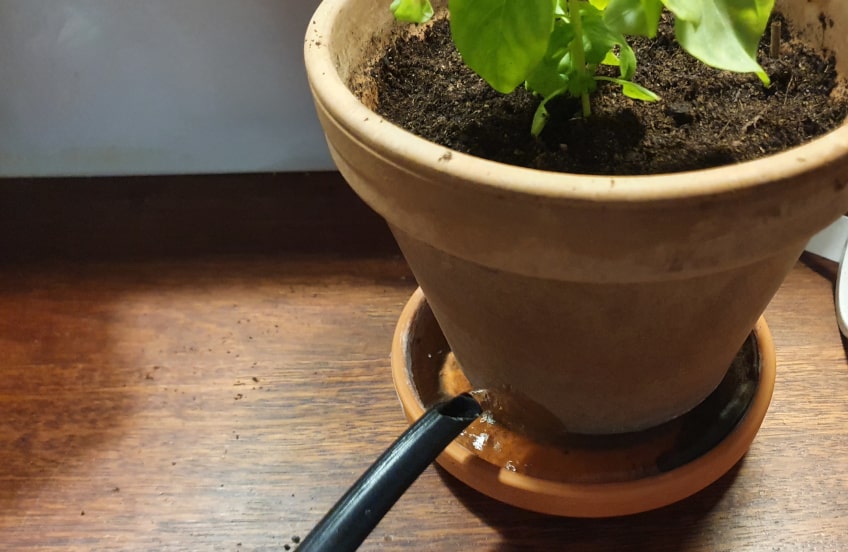
Bottom watering is a simple but incredibly effective thing you can do to help your potted basil. I have another article where I go into depth with why it is so good and how to do it, but the short version is that it encourages the roots to grow and stretch to reach the water, which makes the whole plant stronger.
Bottom watering works by allowing the plant to obtain the water through one or more drainage holes at the bottom, so naturally, you need a pot that has drainage holes. I always use and recommend terra cotta pots with a drainage hole at the bottom since the material is highly breathable and allows any excess moisture to escape through the sides as well as through the drainage hole.
I have a detailed explanation of how you can find the best pot for basil when it comes to size, material, and more. You can find it here.
Potted basil usually needs to be watered a bit more often than basil that grows in the ground since pots can hold limited water. As I have written earlier in this article, you should feel the top of the soil and water when it is dry.
Tips for Watering Basil That Grows in the Ground
Basil plants that grow directly in the ground have slightly different watering needs than potted basil plants.
Here are the key takeaways. I will elaborate below.
- Plant your basil in nutrient-rich soil with good drainage to prevent watering problems.
The type of soil you grow your basil in is important no matter if you grow it in a pot or directly in the ground. You usually have more control over what goes in the soil for potted plants, though, which is why you have to be extra aware of it when you grow basil directly in the ground. So do what you can to find a spot with good soil when you plant your basil in the ground.
Basil grows best in nutrient-rich, well-drained, sandy soil with high amounts of organic matter. The nutrients are, of course, necessary for the plants to grow and thrive and sand significantly improves drainage in the soil, which is important for avoiding problems such as overwatering.
Sometimes soil can contain a lot of clay. Clay essentially has the opposite effect on drainage as sand. Soil with a high clay content does not drain well and is not well-suited for growing basil.
This is just one of the differences between growing basil in pots and in the ground. I have another article where I compare the two methods, so you can see all the advantages of each method and decide which fits you best.
Tips for Watering Basil That Grows Indoors
Like most plants, basil naturally grows outside, but you can actually also grow indoors. It is quite different than growing it outside, though, especially when it comes to watering.
Here is the most important point.
- Basil growing indoors usually doesn’t get as much sunlight as basil growing outside, so it usually doesn’t need as much water.
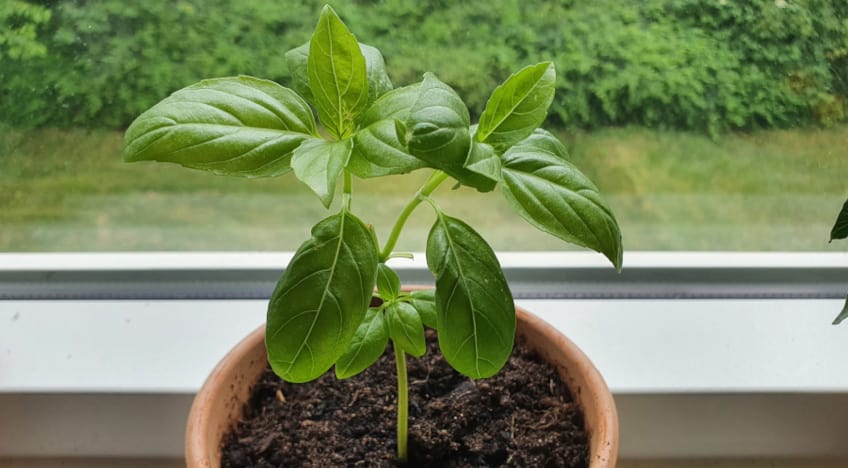
The most significant difference between growing basil indoors and outside is that the plant usually doesn’t get as much sunlight indoors.
You can easily grow basil indoors, especially if you have a south-facing window, but it will still not get nearly as much sunlight as outside, where it can get sunlight from all angles throughout the day.
Since basil growing indoors doesn’t get as much sunlight as it would outside, it doesn’t use as much water. For that reason, you usually don’t have to water it as much. That said, basil that grows outside also gets rain sometimes, which, of course, also affects how much you have to water it.
Feel the soil before you water your basil. If the top of the soil is dry, water the plant. If the soil is wet or moist to the touch, don’t water it.
Tips for Watering Basil That Grows Outside
There are a lot of advantages to growing basil outside such as high amounts of sunlight, rain helping water your plants, and the space for the plants to become large and productive.
When it comes to watering basil that grows outside, there are a couple of things you need to keep in mind, though.
- You need to water more often in warm and sunny periods and less in cold and cloudy periods.
- Consider how much rain there has been recently when watering and water your basil less (or not at all) in rainy periods.
Basil plants absolutely love sunlight and high temperatures, and it usually gets more of both of those outside than indoors, which is an excellent advantage.
You just have to keep in mind that the weather means close to everything when it comes to watering. You don’t have to consider this as much for basil growing inside. Sure, the amount of sunlight changes, but it (hopefully) doesn’t rain inside.
Incorrect watering can lead to a number of different problems such as pests and diseases. For more info on common problems when growing basil, you can read the article on this link where I cover 12 of them.
Read My Complete Guide to Growing and Caring for Basil
I have written a thorough guide where I cover all parts of growing your own basil including choosing a variety, sowing the seeds, the best growing conditions, pruning, propagation, harvesting, storing, solving various problems, and a lot more. You can find the article on this link.

